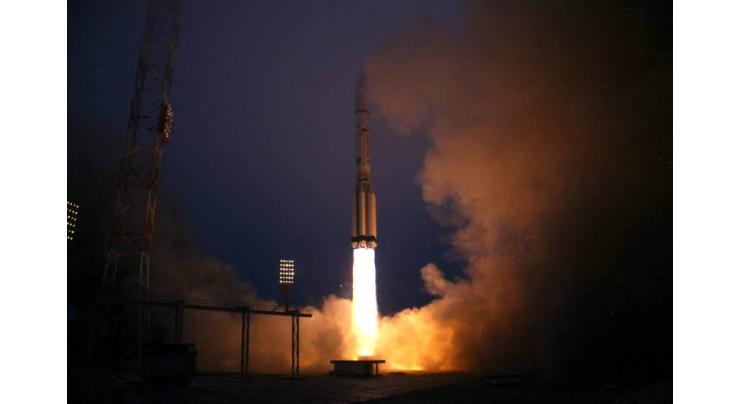
- Home
- Technology
- News
- Russia's Proton-M Places Breeze-M Upper Stage With 2 Satellites Into Suborbital Trajectory
Russia's Proton-M Places Breeze-M Upper Stage With 2 Satellites Into Suborbital Trajectory
Daniyal Sohail Published October 09, 2019 | 04:32 PM

Russia's Proton-M heavy-class carrier rocket, which was launched from Baikonur spaceport earlier on Wednesday, has placed its Breeze-M upper stage with the European Eutelsat 5 West B communications satellite and the US Mission Extension Vehicle-1 satellite refueling spacecraft into the suborbital trajectory
MOSCOW (UrduPoint News / Sputnik - 09th October, 2019) Russia's Proton-M heavy-class carrier rocket, which was launched from Baikonur spaceport earlier on Wednesday, has placed its Breeze-M upper stage with the European Eutelsat 5 West B communications satellite and the US Mission Extension Vehicle-1 satellite refueling spacecraft into the suborbital trajectory, with the process being broadcast on the website of Russian State Space Corporation Roscosmos.
Taking the satellites to orbit will take record-long almost 16 hours. The Eutelsat 5 West B is expected to separate from the upper stage on October 10, at 4.54 a.m. Moscow time (01:54 GMT), while the Mission Extension Vehicle-1 is expected to separate shortly after, at 5.12 a.m. Moscow time.
The Eutelsat 5 West B, with its launch mass totaling 2,864 kilograms (6,314 Pounds), has been produced by Airbus Defence and Space и Northrop Grumman for the Eutelsat satellite communications company.
It is expected to work on the geostationary orbit for 15 years, providing telecommunications services on the territories of France, Italy and Algeria.
The Mission Extension Vehicle-1, with its launch mass totaling 2,326 kilograms, has been produced by Northrop Grumman for its subsidiary SpaceLogistics. Its lifespan is expected to reach 15 years. The spacecraft will be working on expanding the lifespan of satellites operating on the geostationary orbit. Due to being refueled by the Mission Extension Vehicle-1, the Intelsat 901 will be able to extend its mission by 5 years.
Recent Stories

Robinson, bowlers help New Zealand go 2-1 up against Pakistan

Shahzeb Chachar to hold khuli kachehri on April 26

Heatwave amid Israel's aggression in Gaza brings new misery, disease risk

Tourism must change, mayor says as Venice launches entry fee

Court adjourns Judicial Complex attack case till May 17

Nasreen Noori’s book ‘Popatan Jahra Khwab’ launched

Wafaqi Mohtasib inspection team visits Excise and taxation office

AJLAC announces 5th Conference titled ‘People’s Mandate: Safeguarding Civil ..

Pak-US officials engage to enhance trade, investment ties

IBCC to promote educational excellence, expand regional presence

Pakistani 'Blue Helmets' serving UN Peacekeeping Mission in DR Congo set to leav ..

Putin says plans to visit China in May
More Stories From Technology
-

Punjab CM inaugurates Pakistan’s first Virtual Women Police Station
2 days ago -

Pro Tips: How to Capture Stunning Portraits with the Aura Light Portrait of vivo V30 5G
4 days ago -

Itel celebrates launch of S24—a new brand identity
4 days ago -

Realme C53 Price Slash: High-Tech Meets High Style at New Low Price!
5 days ago -

Take Charge, Live Free: Empower Your Life with Infinix NOTE 40 Series
7 days ago -

PTA Undertakes Consultation with All Pakistan Network Association (APNA) on Proposed Class Value Add ..
7 days ago
-

Vivo V30 5G: The Perfect Blend of Enhanced Photography and Premium Design
9 days ago -
PITB's Regional Plan 9 invites applications for its newly launched incubation centers in Rawalpindi, ..
10 days ago -

Pakistan calls for enhanced information integrity on digital platforms
10 days ago -

Infinix NOTE 40 Series vs. the Competition: Why It Stands Out
10 days ago -

"Unlock Exceptional Value: The New realme Note 50 with Extended Warranty Now Available in Pakistan!� ..
11 days ago -

Google unveils new AI chips, arm-based processor for data centers
16 days ago










